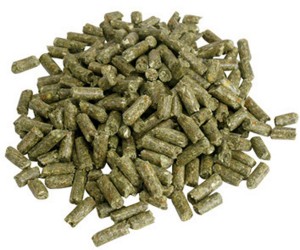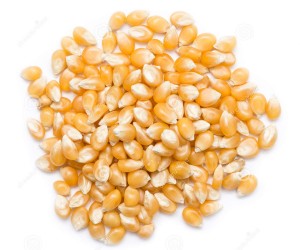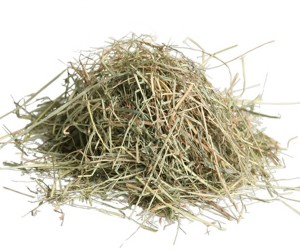Quality Feed & Clean Water…
Pellets
 On average, rabbits eat approximately 1 oz of pellets per pound of body weight. The best type of pellets for the Holland Lops contains 15-17% protein, 20-25% fiber, and between 1.5-3% fat. Diets with excessive protein levels can cause unnecessary weight gain and loose stools for some rabbits, so it’s always good to watch flesh condition and droppings for consistency. Special care should be given when changing a rabbit’s diet, and taking a few weeks to switch to a new pelleted feed will help ensure each transition phase is well-tolerated by the rabbit. For example, start by feeding 3/4 old feed pellets to 1/4 new pellets the first week, then feed 1/2 and 1/2 the second week, followed by 1/4 old pellets to 3/4 new pellets the third week, and then finally switch them completely over to the new feed. Regardless of the transition plan used, special care should always be taken not to upset the rabbit’s sensitive digestive system and gut flora since the result can be fatal. Providing probiotics, like Probios (our favorite), Ben-Bac or Fastrack, along with unlimited quality (i.e. green, sweet smelling, few seed heads, not dusty or molding) timothy grass hay can be helpful when transitioning pellets or changing diets. Please keep in mind that breeders should always provide plenty of transition pellets when selling their rabbit, so please don’t hesitate to remind them if they forget. We currently feed Summit Rabbit Pellet (16.0% protein, 3.0% fat, 22.0% fiber, “no-corn” formula with probiotics included). Summit is a great rabbit pellet formulated for optimum nutrition, extreme palatability and growth and development (all ages) while supporting prime performance for show and production! Summit Rabbit Pellet is a custome made feed that we get milled specially for our herd, however we do sell our feed upon request. For more information regarding our Summit feed, please feel free to contact us anytime.
On average, rabbits eat approximately 1 oz of pellets per pound of body weight. The best type of pellets for the Holland Lops contains 15-17% protein, 20-25% fiber, and between 1.5-3% fat. Diets with excessive protein levels can cause unnecessary weight gain and loose stools for some rabbits, so it’s always good to watch flesh condition and droppings for consistency. Special care should be given when changing a rabbit’s diet, and taking a few weeks to switch to a new pelleted feed will help ensure each transition phase is well-tolerated by the rabbit. For example, start by feeding 3/4 old feed pellets to 1/4 new pellets the first week, then feed 1/2 and 1/2 the second week, followed by 1/4 old pellets to 3/4 new pellets the third week, and then finally switch them completely over to the new feed. Regardless of the transition plan used, special care should always be taken not to upset the rabbit’s sensitive digestive system and gut flora since the result can be fatal. Providing probiotics, like Probios (our favorite), Ben-Bac or Fastrack, along with unlimited quality (i.e. green, sweet smelling, few seed heads, not dusty or molding) timothy grass hay can be helpful when transitioning pellets or changing diets. Please keep in mind that breeders should always provide plenty of transition pellets when selling their rabbit, so please don’t hesitate to remind them if they forget. We currently feed Summit Rabbit Pellet (16.0% protein, 3.0% fat, 22.0% fiber, “no-corn” formula with probiotics included). Summit is a great rabbit pellet formulated for optimum nutrition, extreme palatability and growth and development (all ages) while supporting prime performance for show and production! Summit Rabbit Pellet is a custome made feed that we get milled specially for our herd, however we do sell our feed upon request. For more information regarding our Summit feed, please feel free to contact us anytime.
Corn Facts
 The hull of a corn kernel, either fresh or dried, is composed of an indigestible composition of complex polysaccharide known to cause life-threatening intestinal impaction and blockage in rabbits. Whereas, a rabbit’s natural diet is comprised of digestible cellulose and pectin, of which plant cell walls are commonly composed. According to studies at the U of Miami, rabbits that suffer intestinal impaction because of indigestible corn hulls also have fecal pellet composition of nearly solid corn hulls. Another concern is that corn is nutritionally imbalanced because it contains approximately 71% starch. In comparison, the starch levels in a rabbit’s natural diet would consist of leafy green foods that are much lower in starch than corn. For example, the minimum and maximum starch levels of common forges range from 11% (alfalfa) to 22% (oat hay) with the starch level of grass hay falling in the middle. Combined with the fact that corn is not digested in the foregut, like grass, but rather proceeds to the hindgut where corn’s high starch levels ferment and pose even greater threats to the health of rabbits. More specifically, the fermentation process produces lactic acid and effectively lowers the hindgut PH. In turn, lower PH levels destroy beneficial bacteria needed for the normal fiber digestion. During this process, gram negative bacteria, like clostridium, can proliferate at an alarmingly dangerous rate which significantly increases the chances of enteritis and death.
The hull of a corn kernel, either fresh or dried, is composed of an indigestible composition of complex polysaccharide known to cause life-threatening intestinal impaction and blockage in rabbits. Whereas, a rabbit’s natural diet is comprised of digestible cellulose and pectin, of which plant cell walls are commonly composed. According to studies at the U of Miami, rabbits that suffer intestinal impaction because of indigestible corn hulls also have fecal pellet composition of nearly solid corn hulls. Another concern is that corn is nutritionally imbalanced because it contains approximately 71% starch. In comparison, the starch levels in a rabbit’s natural diet would consist of leafy green foods that are much lower in starch than corn. For example, the minimum and maximum starch levels of common forges range from 11% (alfalfa) to 22% (oat hay) with the starch level of grass hay falling in the middle. Combined with the fact that corn is not digested in the foregut, like grass, but rather proceeds to the hindgut where corn’s high starch levels ferment and pose even greater threats to the health of rabbits. More specifically, the fermentation process produces lactic acid and effectively lowers the hindgut PH. In turn, lower PH levels destroy beneficial bacteria needed for the normal fiber digestion. During this process, gram negative bacteria, like clostridium, can proliferate at an alarmingly dangerous rate which significantly increases the chances of enteritis and death.
Based on our experience raising rabbits and confirmed by studies, we highly recommend NOT feeding corn-based pellets to your rabbits. If you are unsure of whether a rabbit feed contains corn, simply check the ingredient label listed on any bag, call the manufacturer for information, or visit the websites of other popular “no-corn” rabbit pellet formulas manufacturers such as: Heinhold General (16%), Manna Pro Select Series (16%-18%), Pen Pals Professional (16%), Purina Show (16%), Albers Rabbit Feed (16%-18%), and Kent Feeds Top Show (16%-17%).
Supplements & Treats
 Supplements are not typically necessary when feeding a quality pellet, but many owners like to condition their rabbits for show and overall optimum health. In this case, a good mixture is old fashioned rolled oats (like Quaker Oats, but not the instant or quick cooking oats!), rolled barley, and a conditioner, like ADM’s ShowBoost or Manna Pro’s Calf Manna, fed in a 1:1:1 ratio. Some people lightly coat the mixtures with wheat germ oil, but we do not. We feed 1 tbsp. to rabbits over 3 months of age daily and no more than 1 tsp. to younger kits.
Supplements are not typically necessary when feeding a quality pellet, but many owners like to condition their rabbits for show and overall optimum health. In this case, a good mixture is old fashioned rolled oats (like Quaker Oats, but not the instant or quick cooking oats!), rolled barley, and a conditioner, like ADM’s ShowBoost or Manna Pro’s Calf Manna, fed in a 1:1:1 ratio. Some people lightly coat the mixtures with wheat germ oil, but we do not. We feed 1 tbsp. to rabbits over 3 months of age daily and no more than 1 tsp. to younger kits.
Treats and greens are best not fed to rabbits under 6 months of age. For those older rabbits, an occasion treat might include one of these: a random half-inch slice of banana, few stems of clover, dandelion leafs (not fertilized or treated for weeds if from the lawn), cilantro, kale, parsley, a few cheerios or Triscuits. Never feed iceberg lettuce, cabbage, brussels sprouts, or broccoli since the gas and diarrhea that can follow is often deadly. Our favorite rabbit treat is Triscuits…most of our rabbits absolutely love them and our does get one every morning when we make our rounds to check their babies! Triscuits also make excellent show snacks and they’ve also found them to be very helpful when trying to befriend new rabbits! We purchase ours in a 3-pack from Costco.
Hay
 Perhaps the single most important item in a rabbits diet is quality hay. It should be fed at least 1-2x week to adults and daily to babies and sick rabbits to help ensure ingestion of long fiber needed in their diet. More specifically, hay is helpful for building or maintaining gut flora and preventing intestinal impaction caused by ingested hair. Alfalfa or clover hays, although tasty for the rabbit, are typically too rich in protein and calcium to be fed safely. Instead, offer clean fresh grass (i.e. green, sweet smelling, few seed heads, not dusty or molding) hay such as timothy, oat, coastal, brome, Bahia or wheat. If you can’t find good quality hay from a local farmer or feed store, mail ordering hay from Oxbow Hay Company or American Pet Diner is another option. Oxbow Animal Health carries a “first cut” timothy hay that is coarser and higher in fiber than “second cutting” hay. However, American Pet Diner carries both first and second cutting and some rabbits prefer the softer, more fragrant “second cut” to first.
Perhaps the single most important item in a rabbits diet is quality hay. It should be fed at least 1-2x week to adults and daily to babies and sick rabbits to help ensure ingestion of long fiber needed in their diet. More specifically, hay is helpful for building or maintaining gut flora and preventing intestinal impaction caused by ingested hair. Alfalfa or clover hays, although tasty for the rabbit, are typically too rich in protein and calcium to be fed safely. Instead, offer clean fresh grass (i.e. green, sweet smelling, few seed heads, not dusty or molding) hay such as timothy, oat, coastal, brome, Bahia or wheat. If you can’t find good quality hay from a local farmer or feed store, mail ordering hay from Oxbow Hay Company or American Pet Diner is another option. Oxbow Animal Health carries a “first cut” timothy hay that is coarser and higher in fiber than “second cutting” hay. However, American Pet Diner carries both first and second cutting and some rabbits prefer the softer, more fragrant “second cut” to first.
Water
 Providing fresh clean water is one of the most important factors for maintaining a rabbit’s good health. Water can be fed in ceramic crocks, bowls, or water bottles. If using water bottles for adult rabbits, you may want to purchase a bottle that holds a minimum of 16-32 ounces so it’s heavy enough that the rabbit doesn’t knock it off the cage. For this reason, special crocks for pellets and water, like e-z locks, are made that attach to the cage wire; we have used them with great success, especially in our carriers. For everyday use, we believe stainless steel bowls provide additional benefits over using porcelain or plastic bottles and crocks. For example, stainless steel bowls don’t absorb orders, stain, rust, and they resist scratches and chips that can harbor harmful bacteria. Being less porous than plastic, stainless steel bowls are also easier to clean and sanitize. And for those living in the north, the stainless steel crocks from PetEdge are also easy to de-ice on frigid winter days too! Finally, for young litters, we also like to fill 4″ PVC flat end caps with pellets and set them on the cage floor for easy access. We purchase ours at Lowe’s, and they’re located against the back wall in their garden section. To help maintain good health, all types of drinking containers should be cleaned daily and sanitized at least every week with feed containers.
Providing fresh clean water is one of the most important factors for maintaining a rabbit’s good health. Water can be fed in ceramic crocks, bowls, or water bottles. If using water bottles for adult rabbits, you may want to purchase a bottle that holds a minimum of 16-32 ounces so it’s heavy enough that the rabbit doesn’t knock it off the cage. For this reason, special crocks for pellets and water, like e-z locks, are made that attach to the cage wire; we have used them with great success, especially in our carriers. For everyday use, we believe stainless steel bowls provide additional benefits over using porcelain or plastic bottles and crocks. For example, stainless steel bowls don’t absorb orders, stain, rust, and they resist scratches and chips that can harbor harmful bacteria. Being less porous than plastic, stainless steel bowls are also easier to clean and sanitize. And for those living in the north, the stainless steel crocks from PetEdge are also easy to de-ice on frigid winter days too! Finally, for young litters, we also like to fill 4″ PVC flat end caps with pellets and set them on the cage floor for easy access. We purchase ours at Lowe’s, and they’re located against the back wall in their garden section. To help maintain good health, all types of drinking containers should be cleaned daily and sanitized at least every week with feed containers.




